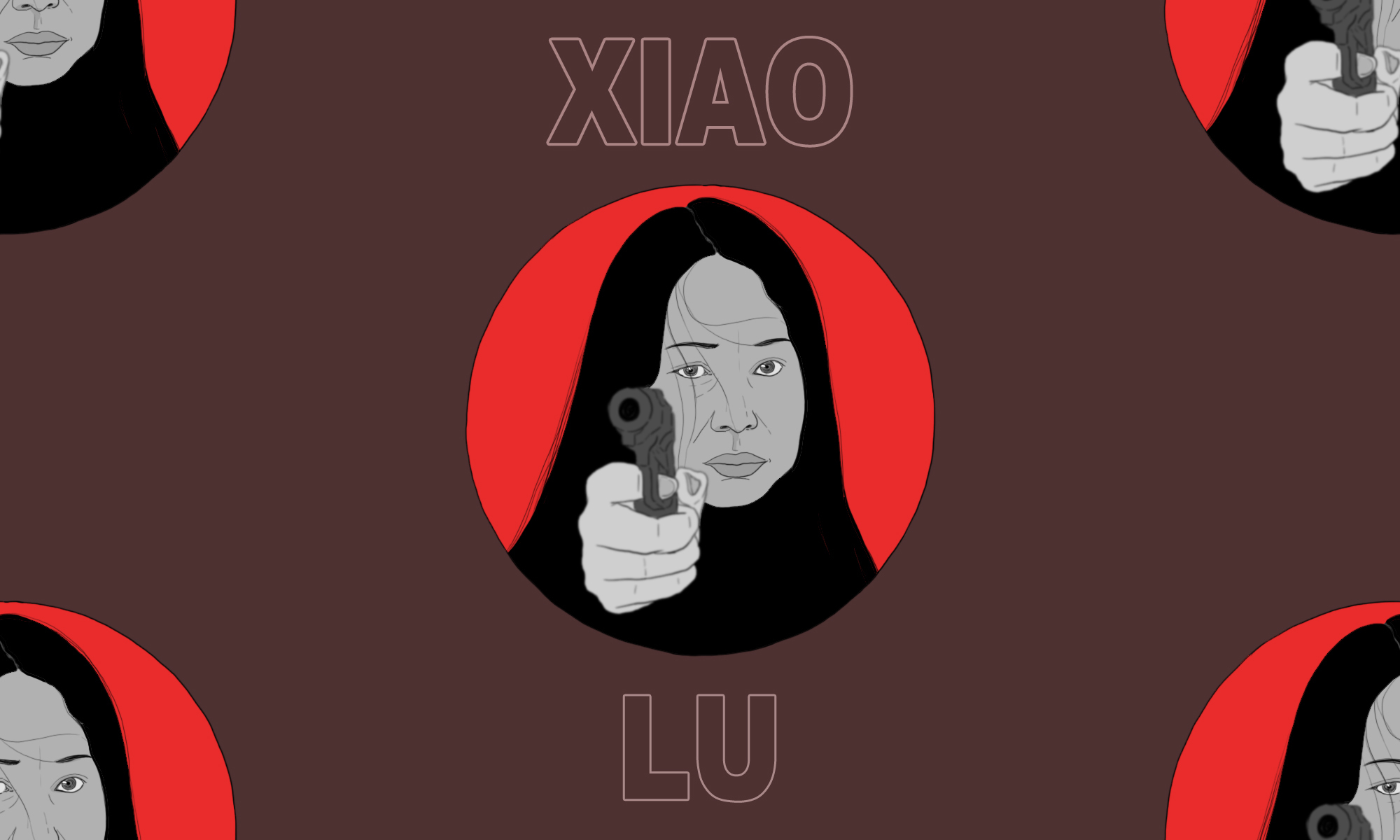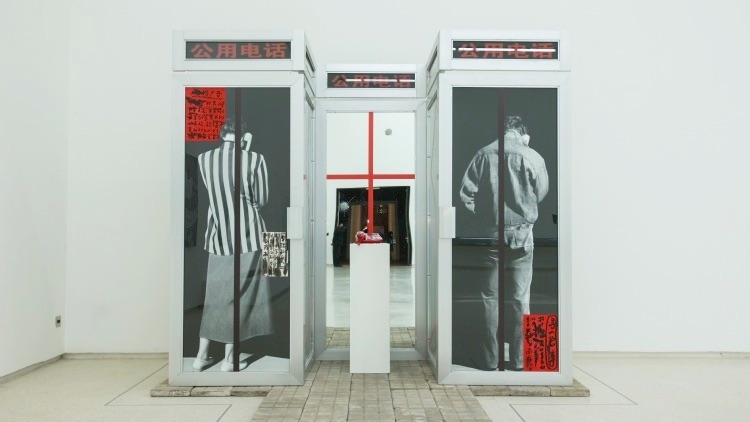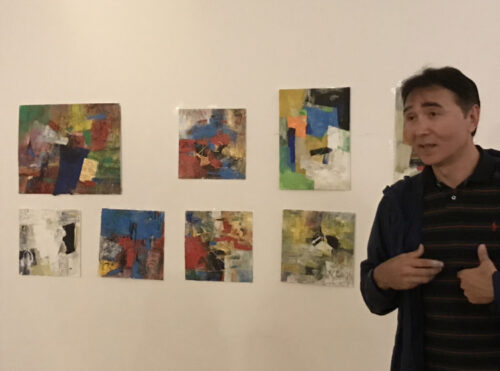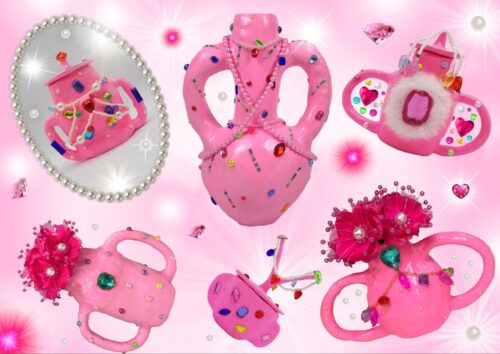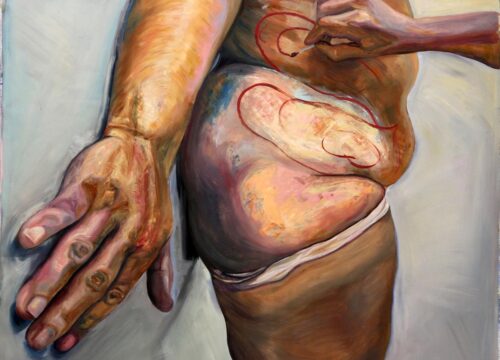It was February 5, 1989, and the opening day of the China Avant-Garde exhibition at Beijing’s National Art Museum was a madhouse. Performance artists had been banned from the space (and those exhibiting banned from discussing “pornography” and “political issues”), but somehow they still sneaked their demonstrations in. One man sold shrimp from a food stall in the corner, insisting to his peckish customers that this was “art.” A second squatted over a clutch of eggs like a chicken, and a third washed his feet in a bowl decorated with pictures of Ronald Reagan. A trio of men floated through the galleries dressed in white mourning clothes, while yet another hurled hundreds of condoms onto the floor. They really tried very hard to provoke. The exhibition was the high-water mark of the ’85 New Wave: pushing the boundaries of social acceptance was what this art movement was all about; the exhibition’s emblem was a “No U-Turn” sign, after all.
But their thunder was stolen by two gunshots echoing from the east wing gallery on the first floor at around 11:10 a.m. In the chaos that followed, people started saying that a 26-year-old art student in a brown cape had shot her own artwork with an army-issued pistol.
The state (well and truly triggered) was having none of it. The museum closed immediately and was surrounded by riot police. The art student and a male accomplice were imprisoned, but then released four days later. They issued a statement saying “We are not interested in politics,” bolted for Hangzhou, and that, it appeared, was that.
But the so-called “shooting incident” was instantly immortalized, swept up in the social and political hurricanes of 1989, and all the interpretations that came with it. Press and critics saw it as a choice example of the newfound boldness of an art scene so rapidly transformed from the Mao era. It mesmerized the foreign press, with Time Magazine summarizing the sensational exhibition with a sensational headline: “Condoms, Eggs and Gunshots.” Influential Chinese art critic Lì Xiàntíng 栗宪庭 called the shooting the “curtain call of the New Wave,” an opening volley for China’s entry into modern art. With distant hindsight, some dubbed this episode of two passionate young things unwittingly poking the Party wasp nest “the opening shots of Tiananmen.”
In all the excitement, everyone forgot about the gun-wielder herself. Xiào Lǔ 肖鲁 kept her reasons for the shooting a secret until 2010. They were personal, deeply traumatic, and had absolutely nothing to do with social revolution or the New Wave.
Who is Xiao Lu?
Xiao Lu chose to remain silent in the shooting’s confused aftermath, allowing her fellow prisoner and future boyfriend Táng Sòng 唐宋 to confidently explain the work. This rapidly made her spokesperson a co-artist in the eyes of the world, and neither Tang nor Xiao Lu contradicted the assumption. But after her split with Tang in 2003, Xiao Lu announced Dialogue had been created solely by her. She wrote a book in 2010 called Dialogue, revealing some crucial details for the first time. Most of what follows comes from this book — her side of the story.
Her parents were traditional Socialist Realist artists, old revolutionaries who desired their daughter to enter an arranged marriage — her groom-to-be would later abandon Xiao Lu for her best friend — and banned her from becoming a dancer. But she always had a rebellious streak, giggling while copying out a banned love story lent to her as a teenager in the mid-1970s, relishing the ownership of something prohibited. Out of boredom when recovering from a foot injury, she asked her father if she could become a painter — and was immediately supplied with Soviet art books to get her started.
By the time she got into the Oil Painting Department at the Zhejiang Academy of Fine Arts (the school where her father happened to be president), China was rapidly changing. The official college training was still socialist and stuffy, but after class the cool students were devouring books of Western philosophy. “At that time if you didn’t talk about philosophy when you were in love with a girl, the girl wouldn’t treat you well,” Xiao Lu later said about the school’s male students.
But it was also during this time that she was sexually abused by her father’s best friend, a prominent Socialist Realist artist who had been asked to counsel and guide her during her studies in Beijing. “I wanted to let you know something about what happens between men and women,” he explained. “When you meet a boyfriend you like afterwards, you’ll know what to do now.”
Xiao Lu now saw relationships as something painful, almost deathly. She was traumatized and emotionally confused, and began associating traditional oil painting with her attacker. Modern art “seemed like the injection of a tonic which could temporarily cure my ailing spirit.” But she still hoped the old man could help her out of her rut. When she called him from a phone booth saying she suspected he was the reason she was emotionally scarred, he snapped that she had no one to blame but herself, and hung up.
It led to Dialogue, made for her graduation in 1988. The piece is filled with broken connections between the sexes — “a dialogue without dialogue” — the aluminium phone booths pasted with full-length pictures of a man and a woman with their backs turned, separated by a mirror and a red phone on a raised dais, its receiver left dangling.
The way Xiao Lu tells it, a teacher suggested that it was too perfect, too neat. A little destructive force needed to be injected before the work was complete. It needed to be destroyed, he said casually, perhaps with a gun. She became obsessed with the idea, her dreams filled with the sound of gunshots, easing her depression and sating her “mortal hatred” for love. She arranged to borrow a gun and shoot the piece before the Academy’s graduation exhibition, but the opportunity was missed. The artwork was still unfinished.
But Dialogue was going places now, included in the prestigious Zhongguo Meishu Bao (one of the main magazines for New Wave artists), and then selected for exhibition at the China Avant-Garde. For Xiao Lu, a big opportunity presented itself.
Egged on by fellow artist and former soldier Tang Song, she borrowed a gun from an old army friend and marched into the gallery that day with Tang and two cameramen. They recorded as she took aim and fired two bullets into the mirror.
Strangely, Xiao Lu’s highly detailed account contains no discussion between her and Tang Song of what consequences there could be for loudly firing a gun in a public building, in a state that had banned private ownership of firearms since 1966. “‘I’ve arranged to borrow the gun!’ I told him proudly.” Could they really have been so unaware?
But she does recount what was going on inside her head just before she fired:
“Everything around me came to a standstill, the air congealed, I heard the leaping of my pulse. I heard the gunshot ringing in my ears again, heaven and hell, mortal hatred and exhaustion, suffocation in my chest assailed my cerebral nerves for one final time, nothing existed anymore.
I savagely raised my head, raised the gun in my hands, looked straight at my reflection in the mirror, the barrel of the gun aimed at myself.”
Tang was arrested immediately. Xiao Lu hid, escaped, and spent the next few hours dazed on a bus, taking the whole route deep into the suburbs, back past the museum and out into the suburbs again. She returned soon afterwards and turned herself in. Dozens of very high-ranking cadres came to stare at her through a hole in her prison door, but she was released soon afterwards.
Men now controlled the dialogue for Dialogue. Tang became her self-appointed spokesperson in the days after their release, “explaining the work with amiable frankness, its political, legal and strategic implications and so on and so forth, a huge load of deep vocabulary, causing everybody present to listen to him in fascination.” The idea of opening up about her own trauma didn’t even cross her mind. He issued the statement to a hungry press, an exhausted Xiao Lu signing without even seeing what he had written.
For Li Xianting, the shooting was exactly what the ’85 New Wave needed. Writing in Zhongguo Meishu Bao, the gunshots were proof that a trend he’d seen toward “a decline in their [the movement’s] creative power” was only temporary. Tang and Xiao Lu had faced danger and shown an ability to shock that made all the other exhibits seem “pedantic or sentimental.” They had shown a resourcefulness not seen “since Duchamp,” their ability to find a gun and get away with firing it in public a “demonstration of the degree of elasticity of the Chinese legal system.”
But for Xiao Lu it had been nothing of the sort. Speaking years later to the Beijing Times, she said, “Many people in Chinese academia like to uplift their works and like grand narratives. I am a woman, and women may prefer to pay attention to emotional issues.” Reading Li’s piece, she noticed Tang’s name now appearing alongside (and in front of) Xiao’s, and he said Dialogue was “their” work, which “made me feel rather uncomfortable.”
The two began a relationship soon after, but they fled to Australia after the Tiananmen massacre, Tang smuggled across the Hong Kong border. During this period Xiao scraped by as a street caricaturist, sketching passersby for $20 a pop. They lived off Australian unemployment benefit, each month Xiao paying the rent and buying enough food for two weeks before handing the remaining funds over to Tang to feed his gambling addiction.
Their relationship was destructive, the two fused together by their shared moment in February 1989. According to Xiao’s mother, the moment she met Tang she knew he was “only in love with your gun.” As for Xiao, firing it had been an emotional release, feelings developing for the man who had helped her fulfill her goal. But jealousies flared between them in a toxic cycle.
Calling the shots
The end of her relationship in 2003 fired Xiao into announcing that Dialogue had been solely her idea, sparking debate on the authorship and incurring wrath for attempting to change written history. For many it just looked like petty point-scoring after her breakup. Li Xianting pointed to Tang’s essential role in pushing her to complete the shooting, that the impact of doing it at the National Art Museum was different to Xiao’s original intentions, and that during the shooting he had told her to “fire” twice — direction warranted accreditation. Some pointed out that Dialogue could only ever have been a “completed” work if it had been shot as per Xiao Lu’s plans — making Tang just a valuable assistant or catalyst. Either way, by 2006 a replica of Dialogue sold at auction under Xiao’s name only.
But she felt she had wasted 15 years of youth. 15 Gunshots…From 1989 to 2003 is a series of black and white photos of Xiao, gun pointed at the viewer. Each photo has been shot by the artist — shooting herself as penance. There are 15, one for each year of her relationship with Tang.
Time, perhaps, to move on — and how else but through art. In 2006 she launched a new piece, Sperm, asking male gallery goers to donate sperm samples for her to be put in an awaiting fridge in preparation for a real child she would then have. “The proposal was met with cold refusal and suspicion from the invited men,” a report laconically notes. But after having been talked into two abortions by Tang during their time together, she desperately wanted a child, but with men out of the equation altogether. In 2009 she married herself, climbing out of a black coffin in a white wedding dress, an emcee asking if she was willing to dedicate the rest of her life to herself and her own art. Then she placed a ring on each of her hands.
She remains active today, her website listing a selection of intriguing performance pieces. In 2013’s Purge, she daubed mud from the Beijing-Hangzhou canal onto her naked body — note the symbolism of connecting the city where she met Tang and the capital she was raped in — and washed it away with a skinny dip in the canals of Venice. Originally her gallery space was going to be a church, but she was banned from stepping into it nude. Too heretical.
But one could argue that she never moved on from Dialogue — not only because it’s her most famous work by far. It feels like she (who became famous so young, and fled China for so long) still holds inside her the passionate rebellion of the ’85 New Wave. Although she knew nobody at the exhibition that day, she seethes with the spirit of those mad young performance artists, “a mass of young people wandering between the rational and the irrational, between inhibition and liberation.” As she once wrote in a letter to a colleague, “Passion is the most precious memento of that era.”
Chinese Lives is a weekly series.
